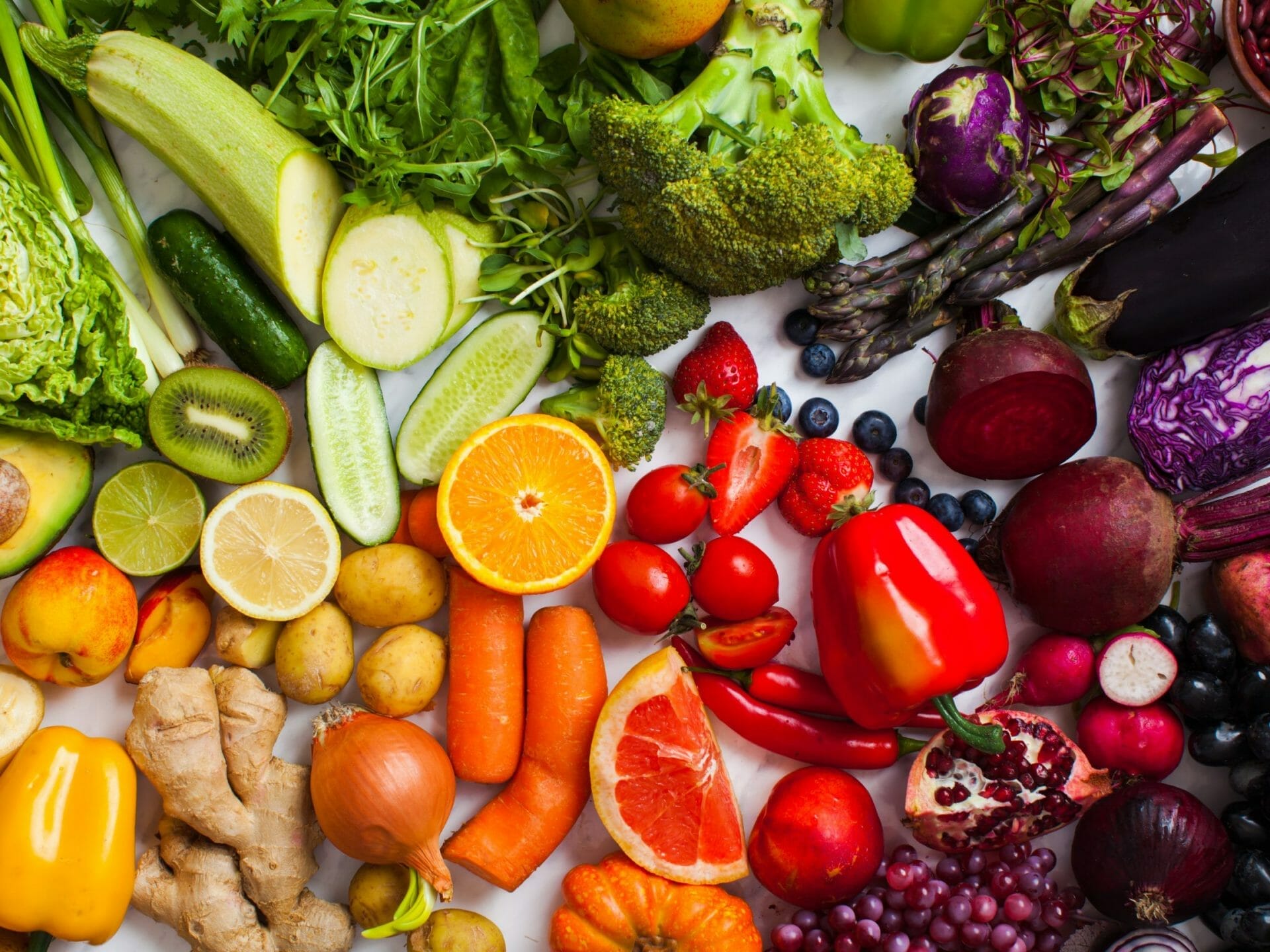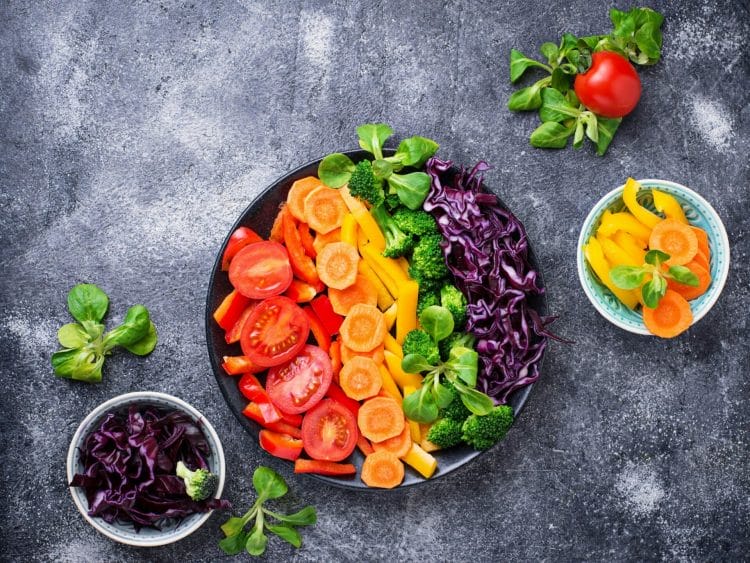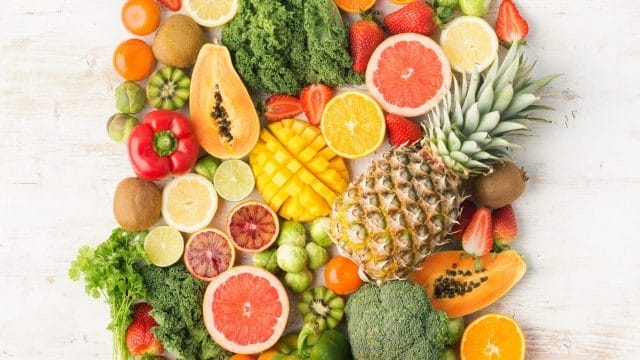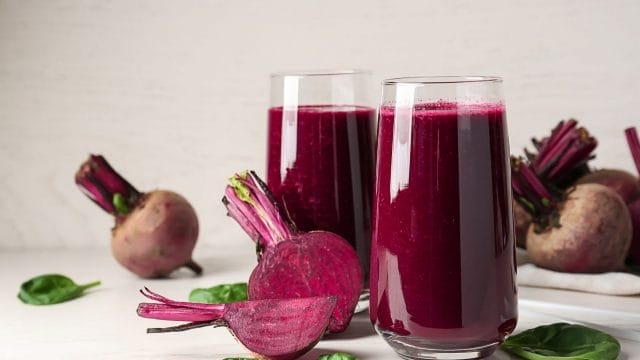Although there is ongoing debate and ever-shifting fads related to what constitutes a “healthy” diet, there is a clear and consistent consensus on the importance of consuming plenty of fruits and vegetables.
Phytonutrients, also referred to as phytochemicals, are compounds produced by plants. Colourful fruits and vegetables are phytonutrient-rich, but so are other plant-based foods, including tea, legumes, nuts, whole grains, herbs, and many spices. There are thousands of different phytonutrients, categorized into phyton groups, including carotenoids, curcuminoids, flavonoids, phytoestrogens, and sulfides. For example, there are more than 600 types of carotenoids alone – the phytonutrient that gives plants their yellow, orange, and red pigments.
Extensive research over many decades suggests that one’s intake of fruits and vegetables is linked with lower risk of many chronic diseases, including cardiovascular disease, certain types of cancer, diabetes, and dementia. Increased consumption of fruits and vegetables has also been linked to numerous psychological benefits, including improved happiness, life satisfaction, well-being, and creativity, as well as lower prevalence of psychological distress.
Fruits and vegetables contain fibre and a wide range of vitamins and minerals. They also contain phytonutrients, which are the compounds that give plants their unique flavours and aromas, as well as their colours.
By eating a wide assortment of coloured fruits and vegetables, often referred to as “eating the rainbow,” your body takes in a variety of phytonutrients, each adding nutritional value to your diet in different ways.
For example, phytonutrients may be anti-microbial, antioxidant, anti-inflammatory, anti-allergic, anti-spasmodic, neuroprotective, and more. Intake of certain phytochemicals has even been linked with decreased mortality.
PHYTONUTRIENT-RICH PLANT FOODS & COGNITION
Researchers in Italy conducted a systematic review of the available research on the effects of antioxidant-rich plant foods on cognition. Thirty-one studies of varying designs were included, involving participants of varying ages, including cognitively healthy individuals, as well as people with mild cognitive impairment (MCI) and dementia.
Seven of the studies reviewed showed significant improvements in all cognitive domains examined, and 19 found significant improvements in select cognitive domains or for just a subset of certain foods. The remaining five studies found either no significant cognitive improvement or no effectiveness.
OVERALL, WE FOUND THAT THE IMPACT OF DIETARY PLANT ANTIOXIDANTS ON COGNITIVE FUNCTION WAS PROMISING, WITH MOST OF THE STUDIES WE REVIEWED SHOWING SIGNIFICANT BENEFICIAL EFFECTS OF ANTIOXIDANT-RICH PLANT FOODS ON COGNITION.
Dr. Luciana Baroni, lead author of the study and Founder and President of the Scientific Society for Vegetarian Nutrition, further explained that in some cases, “the effects were global and in others they affected specific cognitive domains. It’s important to note that the positive cognitive effects found cannot be attributed just to the antioxidant properties. Plant foods contain thousands of different phytonutrients responsible for various important activities in the body, sometimes acting synergistically. That’s potentially why many research studies that have administered ‘isolated’ plant antioxidants as supplements, instead of the whole plant food, have failed to prevent chronic diseases. It looks like the well-orchestrated activities of phytochemicals in whole plant foods cannot be replaced by extracted phytochemicals.” These findings were published in May 2021 in Antioxidants.
PHYTONUTRIENT INTAKE & WOMEN’S MENTAL HEALTH
A different group of researchers looked at the association between consumption of phytonutrient-rich foods and mental health in 488 Iranian women between the ages of 20 and 50. They used a metric called the “dietary phytochemical index” (DPI) to quantify the amount of phytochemical intake.
After controlling for potential confounding variables, the researchers found that women with DPI scores in the top-third had significantly lower prevalence of depressive symptoms, anxiety, and psychological distress than the women in the bottom-third.
THE ASSOCIATION BETWEEN DPI AND MENTAL HEALTH IN WOMEN WAS FOUND TO BE STRONG, WITH THE HIGHER A WOMAN’S INTAKE OF PHYTONUTRIENT-RICH FOODS, THE BETTER HER MENTAL HEALTH.
These findings add to the growing body of research that suggests that diets high in phytochemical-rich plant foods can protect health and, in this case, mental health specifically. These findings were published in May 2019 in British Journal of Nutrition.
BENEFITS BY COLOUR
Each individual fruit and vegetable has numerous effects depending on its phytonutrients and other components. However, there are some general patterns of benefits found in fruits and vegetables of similar colours because each colour corresponds with certain phytonutrient content.
For example, orange fruits and vegetables contain beta-carotene, while green indicates the presence of chlorophyll. Below you will find a summary of some of the known benefits for each colour. (Keep in mind, though, that there may be many additional benefits that are not described below or that perhaps have not yet been discovered or scientifically proven.)
RED fruits and vegetables – including tomatoes, cherries, strawberries, raspberries, cranberries, red apples and pears, watermelon, red grapes, blood oranges, pink grapefruit, radishes, red beets, red bell peppers, red cabbage, red onions, and red potatoes – tend to be high in phytonutrients with antioxidant, anti-inflammatory, and immune-modulating effects. Research has linked one of the phytonutrients found in red fruits and vegetables, lycopene, with protection against prostate cancer and heart and lung disease.
GREEN fruits and vegetables – such as spinach, kale, asparagus, broccoli, alfalfa sprouts, green cabbage, kiwi, avocados, and Brussels sprouts – are rich in cancer-blocking phytonutrients like sulforaphane and indoles.
ORANGE & YELLOW fruits and vegetables – including carrots, oranges, sweet potatoes, yellow peppers, pineapple, mango, pumpkin, apricots, peaches, cantaloupe, and winter squash – often contain beta cryptothanxin, a common carotenoid, which supports communication between cells in your body and may help prevent heart disease.
BLUE & PURPLE fruits and vegetables – including blueberries, blackberries, purple grapes, purple cabbage, eggplant, plums, figs, and prunes – contain anthocyanins, powerful antioxidants that have been linked to delayed aging of cells, as well as support for heart health through blocking blood clot formation.
WHITE & BROWN vegetables – like onions, garlic, leeks, cauliflower, parsnips, and mushrooms – contain important phytonutrients. For example, allicin is found in the onion family and has anti-tumor properties. Other white vegetables contain flavonoids with antioxidant properties, such as quercetin.
ARE YOU EATING ENOUGH FRUITS & VEGETABLES?
Both the 2019 Canada’s Food Guide and The Dietary Guidelines for Americans (2020-2025) emphasize the importance of consuming fruits and vegetables, recommending that combined they should make up approximately half of your total “plate” each day. The ideal quantity varies for each person, depending on age, sex, height, weight, and physical-activity level. For example, the U.S. Dietary Guidelines recommend that people on a 2000-calorie diet should eat two and a half cups of vegetables and two cups of fruit each day.
Unfortunately, research shows that fruit and vegetable intake among Canadians is consistently low (and decreasing over time), with most Canadians not meeting national recommendations. The same is true for Americans.
The following are some tips to help you maximize the benefits of phytonutrients in your diet:
- Set a goal for the amount of fruits and vegetables that you will eat each day. You can use the U.S. Department of Agriculture (USDA) website, www.myplate.gov/myplate-plan, to find out your personalized food group target amounts.
- Aim to eat a wide variety of plant foods, including fruits and vegetables. Some nutrition experts suggest chal- lenging yourself to eat 50 unique plant foods each week.
- Track your intake of phytonutrient-rich foods, noting each unique plant food consumed every day for one week on a tracking sheet, to see if you are achieving your goal.
- Eat the skins! Do not just eat the inner, paler flesh of your fruits and vegetables. Instead, avoid peeling when you can because much of the phytonutrients are contained in the skins.
The dietary phytochemical index (DPI) represents the percentage of energy intake derived from foods rich in phytochemicals, including fruits and vegetables, as well as other plant-based foods like nuts and legumes. Studies have found that the DPI is inversely linked with obesity, elevated cholesterol and blood pressure, insulin resistance, prediabetes, and breast cancer.
If you’re on medication, please check with your doctor before consuming grapefruit. Grapefruit may have dangerous interactions when combined with some popular drugs used for high blood pressure, high cholesterol and depression.
This Article is also available to read in Mind Over Matter Magazine on page 59.




